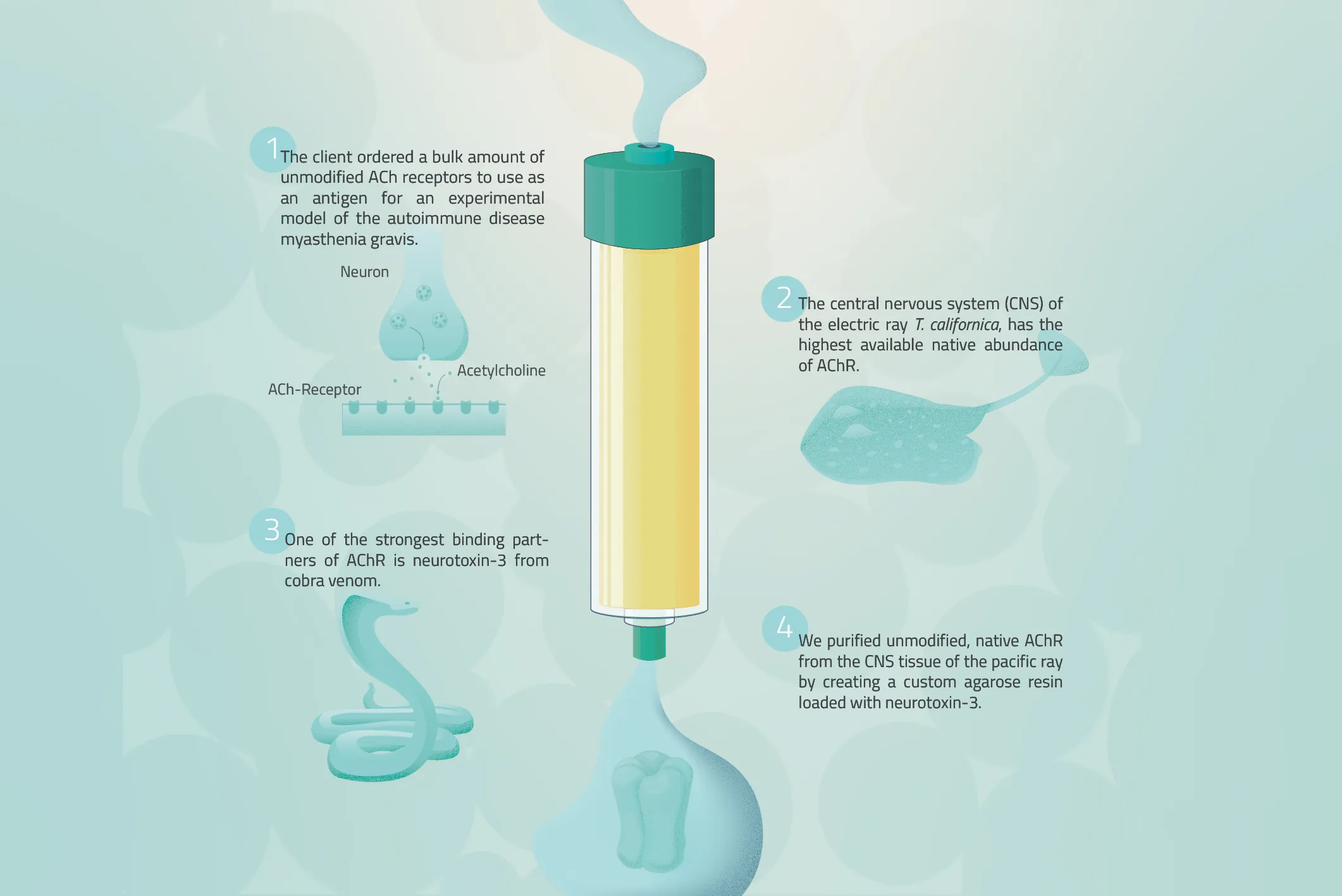Combining Biotechnological Services for Successful Protein Production: The Case of AChR
Bite-size Biotech
At Cube Biotech, we provide a range of biotechnological services to help researchers and scientists achieve their goals, no matter how complex or challenging they may seem. In this post, we'll concentrate on the tale of one of our more unique projects—the isolation of the acetylcholine-receptor AChR from the electric ray Torpedo californica.
Our client needed a bulk amount of unmodified AChR to use as an antigen for an experimental model of the autoimmune disease myasthenia gravis. This muscular disease is characterized by a chronic, fatigable weakness of voluntary muscles, caused by destruction of the postsynaptic membrane and degradation of the AChR by IgG autoantibodies (Losen et al., 2015). Or to put it simple: The muscles that connect to your bones are weakened which leads to an impairment in body movement and breathing.
High-yield affinity chromatography was not an option due to the "no modifications" condition, which also excluded the utilization of tags. Getting a high protein yield without modifying the protein was a challenge. We had to think outside the box and look for innovative solutions. Our successful idea was to use the central nervous system (CNS) of the electric ray T. californica, which has the highest available native abundance of AChR.
High-yield affinity chromatography was not an option due to the "no modifications" condition, which also excluded the utilization of tags. Getting a high protein yield without modifying the protein was a challenge. We had to think outside the box and look for innovative solutions. Our successful idea was to use the central nervous system (CNS) of the electric ray T. californica, which has the highest available native abundance of AChR.

As affinity tags were not desired, we decided to use the protein’s inherent affinities. One of the strongest binding partners of AChR is neurotoxin-3 from cobra venom. Hence, we purified unmodified, native AChR from the CNS tissue of the pacific electric ray using the ligand neurotoxin-3 covalently coupled to our agarose resin beads. We followed a slightly altered version of the Losen et al. (2015) methodology to optimize the purification. This is an excellent demonstration of how we combined our protein and custom bead services to meet our client's objectives.
It is important to note that this is just one example of our biotechnological capabilities. At Cube Biotech, we offer a range of services, including protein expression, purification, assay development, and custom bead services. We have experience with a wide range of proteins, from enzymes to membrane proteins, and we work with both academic and industry clients.
In conclusion, the successful production of unmodified AChR is a testament to our ability to provide innovative solutions to complex problems. If you have a challenging project, contact us to see how we can help you achieve your goals.
If you would like to learn more about the exciting possibilities of custom beads, please take a look at our more in-depth knowledge page or module four of our in-house Protein Services. There, you can also leave us a message.
It is important to note that this is just one example of our biotechnological capabilities. At Cube Biotech, we offer a range of services, including protein expression, purification, assay development, and custom bead services. We have experience with a wide range of proteins, from enzymes to membrane proteins, and we work with both academic and industry clients.
In conclusion, the successful production of unmodified AChR is a testament to our ability to provide innovative solutions to complex problems. If you have a challenging project, contact us to see how we can help you achieve your goals.
If you would like to learn more about the exciting possibilities of custom beads, please take a look at our more in-depth knowledge page or module four of our in-house Protein Services. There, you can also leave us a message.
Sources
- Losen, M., Martinez-Martinez, P., Molenaar, P.C., et al., (2015) Standardization of the experimental autoimmune myasthenia gravis (EAMG) model by immunization of rats with Torpedo californica acetylcholine receptors — Recommendations for methods and experimental designs, Exp Neurol. 270: 18–28. doi:10.1016/j.expneurol.2015.03.010.


